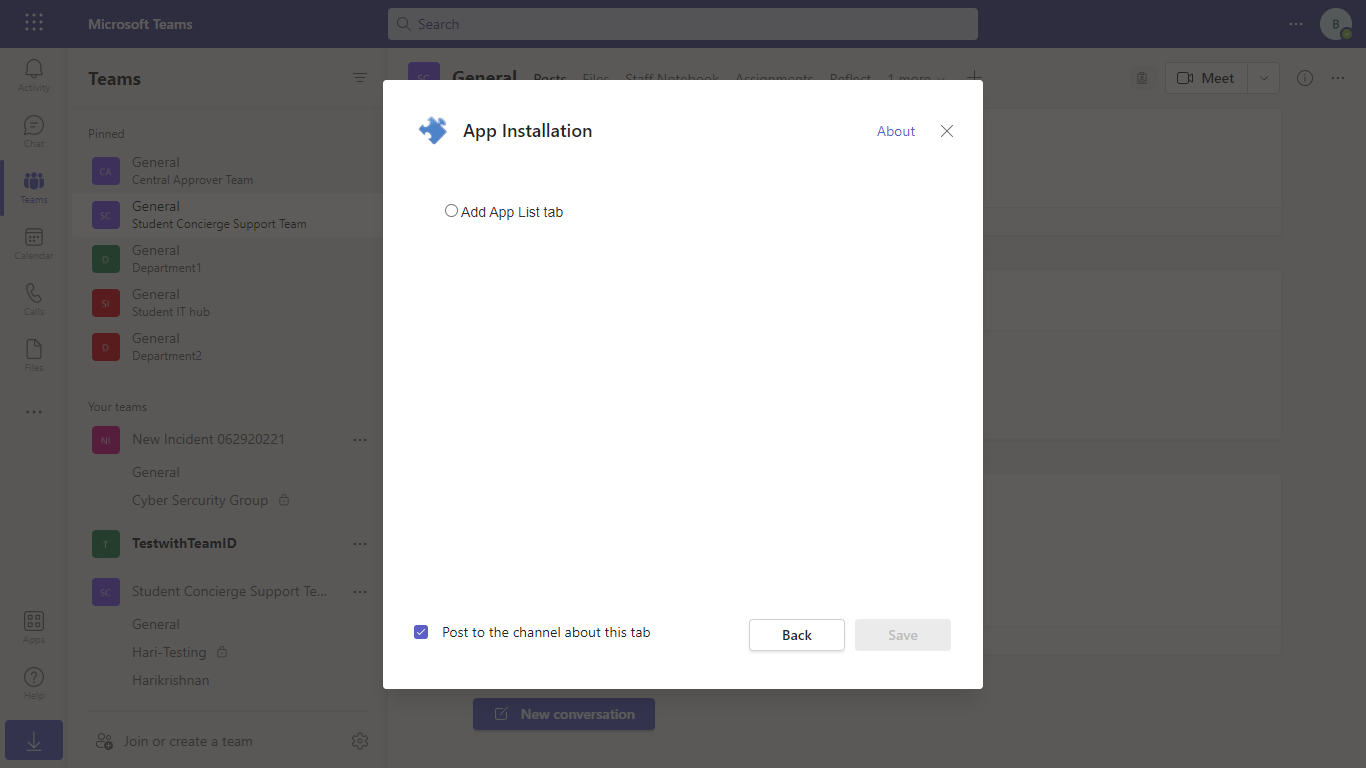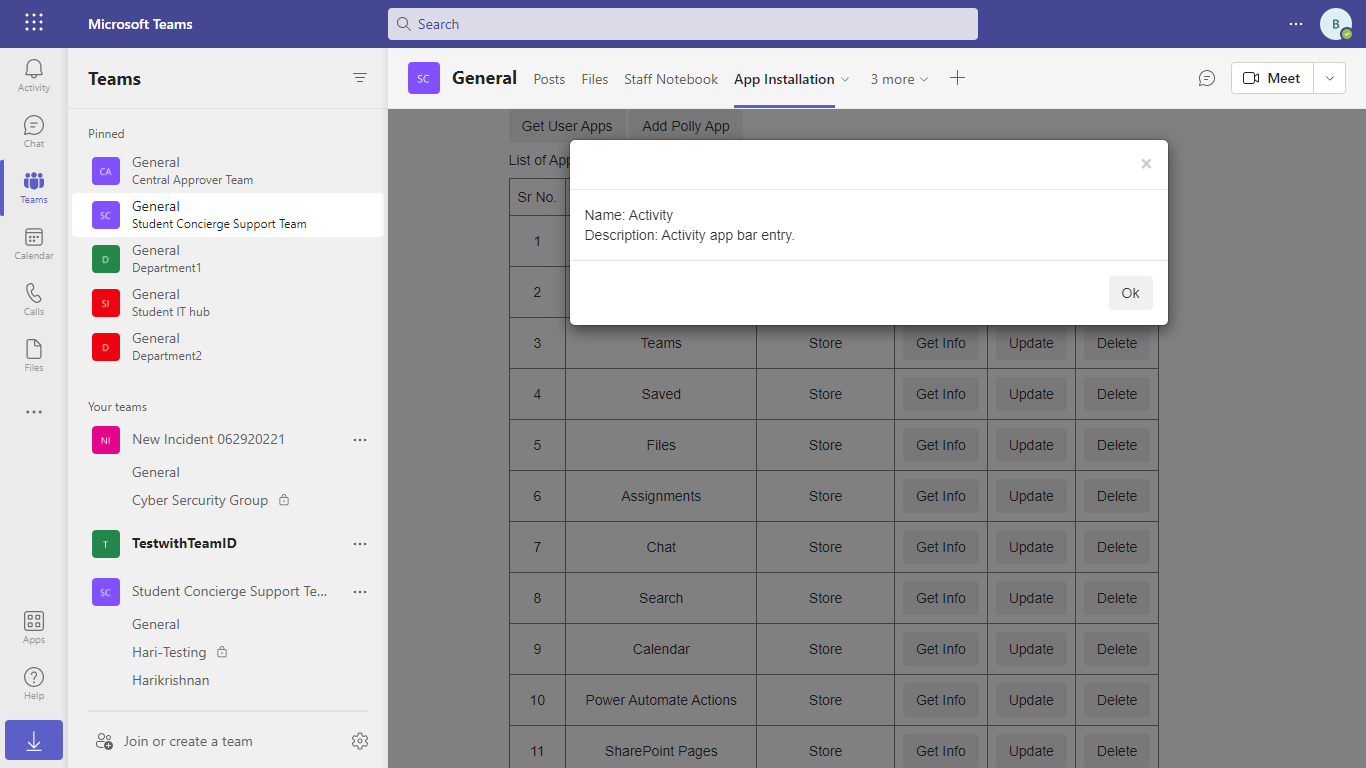App Installation
This sample app demonstarte the installation lifecycle for Teams Apps which includes create, update delete Apps
Included Features
- Tabs
- Graph API
Interaction with app

Try it yourself - experience the App in your Microsoft Teams client
Please find below demo manifest which is deployed on Microsoft Azure and you can try it yourself by uploading the app manifest (.zip file link below) to your teams and/or as a personal app. (Sideloading must be enabled for your tenant, see steps here).
App Installation: Manifest
Prerequisites
.NET Core SDK version 6.0
determine dotnet version
dotnet --versiondev tunnel or Ngrok (For local environment testing) latest version (any other tunneling software can also be used)
Teams Microsoft Teams is installed and you have an account
Setup
- Register a new application in the Microsoft Entra ID – App Registrations portal.
- You need to add following permissions mentioned in the below screenshots to call respective Graph API

- Setup for Bot
Register a Microsoft Entra ID aap registration in Azure portal.
Also, register a bot with Azure Bot Service, following the instructions here.
Ensure that you've enabled the Teams Channel
While registering the bot, use
https://<your_tunnel_domain>/api/messagesas the messaging endpoint.NOTE: When you create your app registration, you will create an App ID and App password - make sure you keep these for later.
- Setup NGROK
Run ngrok - point to port 3978
ngrok http 3978 --host-header="localhost:3978"Alternatively, you can also use the
dev tunnels. Please follow Create and host a dev tunnel and host the tunnel with anonymous user access command as shown below:devtunnel host -p 3978 --allow-anonymous
- Setup for code
Clone the repository
git clone https://github.com/OfficeDev/Microsoft-Teams-Samples.gitModify the
/appsettings.jsonand fill in the following details:{{Your Microsoft App Id}}- Generated from Step 1 while doing Microsoft Entra ID app registration in Azure portal.{{ Your Microsoft App Password }}- Generated from Step 1, also referred to as Client secret
Build your solution
- Launch Visual Studio
- File -> Open -> Project/Solution
- Navigate to
samples/graph-app-installation-lifecycle/csharp/AppInstallationfolder - Select
AppInstallation.csprojfile - Press
F5to run the project
- Setup Manifest for Teams
This step is specific to Teams.
- Edit the
manifest.jsoncontained in the ./AppManifest folder to replace your Microsoft App Id (that was created when you registered your app registration earlier) everywhere you see the place holder string{{Microsoft-App-Id}}(depending on the scenario the Microsoft App Id may occur multiple times in themanifest.json) - Edit the
manifest.jsonforvalidDomainsand replace{{domain-name}}with base Url of your domain. E.g. if you are using ngrok it would behttps://1234.ngrok-free.appthen your domain-name will be1234.ngrok-free.appand if you are using dev tunnels then your domain will be like:12345.devtunnels.ms. - Zip up the contents of the
AppManifestfolder to create amanifest.zip(Make sure that zip file does not contains any subfolder otherwise you will get error while uploading your .zip package)
- Edit the
Upload the manifest.zip to Teams (in the Apps view click "Upload a custom app")
- Go to Microsoft Teams. From the lower left corner, select Apps
- From the lower left corner, choose Upload a custom App
- Go to your project directory, the ./AppManifest folder, select the zip folder, and choose Open.
- Select Add in the pop-up dialog box. Your app is uploaded to Teams.
Upload app manifest file (zip file) to your team
Note: If you are facing any issue in your app, please uncomment this line and put your debugger for local debug.
Running the sample






Further Reading
- Bot Framework Documentation
- Bot Basics
- Azure Bot Service Introduction
- Azure Bot Service Documentation
- Graph-app-installation